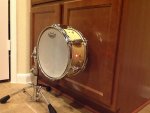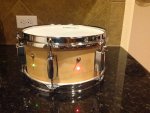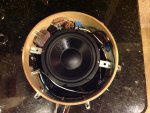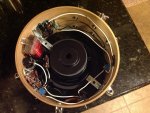wsabol
Gold Member
I built this subkick, and designed some special modifications of my own to make it.. more awesome.
I used a 6.5" woofer, and installed a 20 dB pad.
The major modification I integrated in this microphone is an RLC circuit. These circuits behave like a mass on a spring (or a drum haha): if you excite it, it gives an oscillation decay. You can design to ciruit such that this decay behavior has a specific frequency and sustain (decay time). I designed this one to decay at 50 Hz. I setup a multi-position switch and connected different resistors to it so you can choose a decay time.
It sort of behaves like a trigger, but it could not be less like a trigger. Its all completely analog, no power source or anything like that at all.
I think it can be useful to supplement the kick sound with subfrequency decay. I don't know if it'll be as prominent as say an 808 kick sound, but that's the idea. The more I think about it, the more I think 50 Hz may be too low, but only time will tell.
There are three switches, each with an LED indicator to show when it is on. The first switch turns the whole system on/off, the second engages the pad, and the third engages the oscillator.
I'm excited to try it out. I'll try to get some sound files up as soon as I can.
Let me know what you think!
I used a 6.5" woofer, and installed a 20 dB pad.
The major modification I integrated in this microphone is an RLC circuit. These circuits behave like a mass on a spring (or a drum haha): if you excite it, it gives an oscillation decay. You can design to ciruit such that this decay behavior has a specific frequency and sustain (decay time). I designed this one to decay at 50 Hz. I setup a multi-position switch and connected different resistors to it so you can choose a decay time.
It sort of behaves like a trigger, but it could not be less like a trigger. Its all completely analog, no power source or anything like that at all.
I think it can be useful to supplement the kick sound with subfrequency decay. I don't know if it'll be as prominent as say an 808 kick sound, but that's the idea. The more I think about it, the more I think 50 Hz may be too low, but only time will tell.
There are three switches, each with an LED indicator to show when it is on. The first switch turns the whole system on/off, the second engages the pad, and the third engages the oscillator.
I'm excited to try it out. I'll try to get some sound files up as soon as I can.
Let me know what you think!







